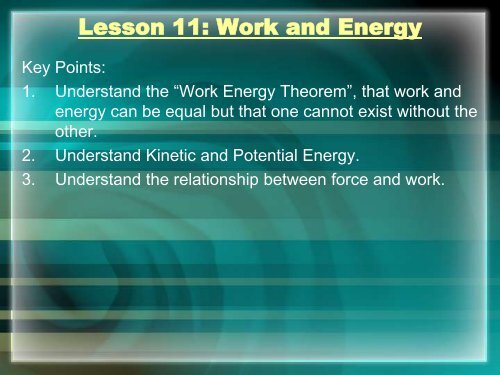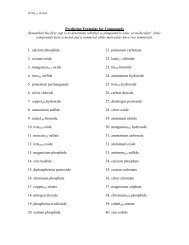You also want an ePaper? Increase the reach of your titles
YUMPU automatically turns print PDFs into web optimized ePapers that Google loves.
Key Points:<br />
Lesson 11: <strong>Work</strong> <strong>and</strong> <strong>Energy</strong><br />
1. Underst<strong>and</strong> the “<strong>Work</strong> <strong>Energy</strong> Theorem”, that work <strong>and</strong><br />
energy can be equal but that one cannot exist without the<br />
other.<br />
2. Underst<strong>and</strong> Kinetic <strong>and</strong> Potential <strong>Energy</strong>.<br />
3. Underst<strong>and</strong> the relationship between force <strong>and</strong> work.
<strong>Energy</strong>, like motion, is a<br />
measurable quantity.<br />
Specifically, energy is a<br />
measure of an object’s (or a<br />
system’s) capacity to do work<br />
(for example a brick held in your<br />
h<strong>and</strong> has the potential to do<br />
work on your toes if it is<br />
dropped). <strong>Work</strong> is the transfer<br />
of energy from one object (or<br />
system) to another.<br />
<strong>Work</strong> <strong>and</strong> <strong>Energy</strong>
<strong>Work</strong> <strong>and</strong> <strong>Energy</strong><br />
For instance, when you hit a tennis ball with your racket, we say the<br />
ball has had work done on it. That is, it gained energy. In this case<br />
the tennis racket caused the ball to move. The racket did work on<br />
the ball, thus transferring energy to the ball.
<strong>Work</strong> <strong>and</strong> <strong>Energy</strong><br />
<strong>Work</strong> is also related to the force acting on an object. The<br />
greater the force, the more work is done (on objects of the<br />
same mass). Mass also effects the amount of work done as<br />
a more massive object requires more energy to move.
<strong>Work</strong> <strong>and</strong> <strong>Energy</strong><br />
For a force to transfer energy to an object, the force must make<br />
the object move (as in the diagram below).
<strong>Work</strong> <strong>and</strong> <strong>Energy</strong><br />
Motion does not just mean the movement of an object from one<br />
place to another. When an object is compressed or stretched, the<br />
atoms within it are moved. Thus changes in the shape of an object<br />
constitute an exertion of force <strong>and</strong> thus result in work <strong>and</strong> energy<br />
transfers.
<strong>Work</strong> <strong>and</strong> <strong>Energy</strong><br />
<strong>Work</strong> <strong>and</strong> Heat are transfers of energy. When the molecules of two<br />
objects originally at different temperatures come into contact with<br />
each other, they collide <strong>and</strong> transfer thermal energy. This transfer<br />
of thermal energy is what we call heat, therefore heat is a transfer<br />
of energy.<br />
www.vias.org/physics/bk2_07_09.html
Potential <strong>Energy</strong><br />
Potential energy is energy due to position or condition. Thus a rock<br />
perched on a cliff in a Road Runner Wiley Coyote cartoon has<br />
potential energy as does a stretched rubber b<strong>and</strong>.
Potential <strong>Energy</strong><br />
Gravitational Potential <strong>Energy</strong> (GE p) is the potential energy of an<br />
object due to its position (as in the diagram above). All forms of<br />
potential energy must be described with respect to a chosen<br />
reference point or condition.
Potential <strong>Energy</strong><br />
We can calculate GE p of an object using the equation below.<br />
E p = mgh<br />
Where:<br />
E p is the gravitational potential energy of the object (in joules)<br />
m is the object’s mass in kilograms<br />
g is the acceleration due to gravity (on earth 9.81m/s 2 )<br />
h is the object’s height above the ground (in meters)
Example 1:<br />
A 3.00kg box is lifted by an upward force 1.50m above the surface<br />
of earth to the top of a table. What is the potential energy of the<br />
box in its new position?<br />
Ep = mgh<br />
= 3.00kg x 9.81m/s2 x 1.50m<br />
= 44.1 J<br />
The gravitational potential energy of the box is<br />
now 44.1 J.
Example 2:<br />
A 55.0kg diver is st<strong>and</strong>ing on a diving platform <strong>and</strong> has a<br />
gravitational potential energy of 5.40 x10 3 J. What is the vertical<br />
height of the platform?<br />
E p = mgh<br />
h = E p / mg<br />
= (5.40 x 10 3 J) / (55.0kg)(9.81m/s 2 )<br />
= 10.0m<br />
The vertical height is 10.0m.
Kinetic <strong>Energy</strong> is <strong>Energy</strong> Due to Motion<br />
When the potential energy of an object is released, that object often<br />
begins to move. Moving objects can do work. A falling hammer can<br />
drive a nail into wood. Moving molecules in hot steam can turn<br />
turbines. Moving molecules in a sound wave can make your<br />
eardrum vibrate.
Kinetic <strong>Energy</strong> is <strong>Energy</strong> Due to Motion<br />
Any moving object has kinetic energy. When a solid object moves,<br />
all the molecules move in unison. The kinetic energy of such an<br />
object is often called mechanical kinetic energy. Even when<br />
molecules are not physically attached to each other, they can still<br />
move together like air molecules in the wind.
Kinetic <strong>Energy</strong> is <strong>Energy</strong> Due to Motion<br />
Thermal energy is the kinetic energy of individual molecules moving<br />
in a r<strong>and</strong>om manner.<br />
The kinetic energy of a moving object is determined by the mass <strong>and</strong><br />
speed of the object. The relationship between kinetic energy, mass<br />
<strong>and</strong> speed is represented by the following equation<br />
E k = ½ mv 2<br />
Where:<br />
E k is the energy of the object (in Joules)<br />
m is the mass of the object (in kilograms)<br />
v is the velocity of the object (in meters per second).<br />
This formula will still produce the proper units for energy<br />
(recall that a joule is actually a kgm 2 /s 2 ).
Questions:<br />
1. Which has more kinetic energy, a semi truck travelling<br />
30km/hr or a bicycle travelling 30km/hr? Why?<br />
2. Water does not always freeze at 0�C it can be cooled to –20<br />
or 30�C if conditions are right. Which has more total thermal<br />
energy, liquid water at -10�C or ice at the same<br />
temperature? Why?<br />
3. You are heating a substance but its temperature is not<br />
increasing what type of energy is being increased? Why?<br />
4. You are cooling hot iron in cold water, what kind of energy is<br />
being lost by the iron? Why?<br />
5. The water in the above question evaporates when the iron<br />
touches it, what type of energy is being increased in the<br />
water? Why?<br />
6. You apply a force of 1000N to a baseball, <strong>and</strong> it travels a<br />
distance of 80m. You apply this same force to a rail car <strong>and</strong><br />
it does not move at all, have you done work in both cases?<br />
Why or why not?



